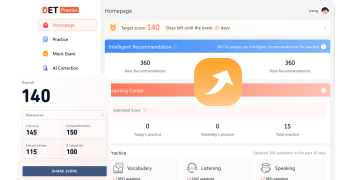Escucha Interactiva Hecha Fácil: Un Marco Simple para Dominar el Nuevo Tipo de Pregunta DET
Hola a todos, bienvenidos a la Práctica DET. Hoy vamos a hablar sobre cómo responder las preguntas de “Interactive Listening”. A diferencia de otros artículos que ofrecen sugerencias generales para mejorar, en este artículo daremos consejos y pasos muy específicos y prácticos. Por favor, lee atentamente; creemos que te ayudará a obtener una mejor puntuación en “Interactive Listening”. ¡Comencemos!
Introducción a los tipos de pregunta
“Interactive Listening” es un nuevo tipo de pregunta introducido en el Duolingo English Test en 2023 y actualizado en 2025. En esta sección, encontrarás varias preguntas presentadas en secuencia. Hay tres tipos principales de preguntas:
1. Escucha y Completa: En esta parte, escucharás un escenario breve y deberás completar 3–4 oraciones, que se presentan como preguntas de rellenar espacios en blanco.
2. Escucha y Responde: Esta sección consiste en preguntas de opción múltiple, cada una con 4–5 opciones de respuesta. Tienes 4 minutos para completar esta parte.
3. Resume la Conversación: Aquí, se requiere que resumas la conversación, contando con 75 segundos para responder.
Si deseas saber más sobre “Interactive Listening”, puedes ver el siguiente video oficial de introducción (inicia alrededor del minuto 0:56):
Alternativamente, si prefieres leer la versión en texto, también tenemos una introducción más detallada de “Interactive Listening” en nuestra otra publicación: https://www.detpractice.com/det-question-type-interactive-listening
Nota: Esta guía ha sido actualizada. Puedes encontrar la última versión aquí: Duolingo English Test Interactive Listening – Guía Completa (Nueva Versión)
Listen and Respond
A diferencia de las preguntas de listening en los exámenes TOEFL o IELTS, las preguntas de “Interactive Listening” en el DET mostrarán poco a poco los guiones de audio. Sí, has leído bien. Esto significa que por cada pregunta que eliges, tendrás una pista anterior (¡buena noticia!).
l Vamos a observar la interfaz de la pregunta:
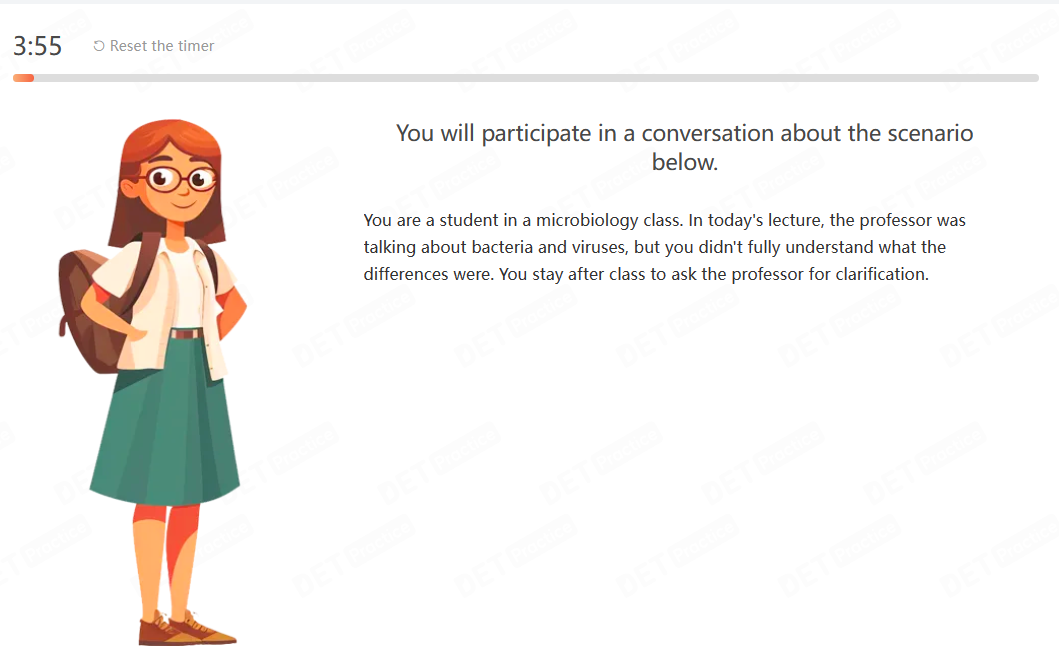
Antes de realizar cada “Listen and Respond”, verás el siguiente Escenario. Veamos qué información nos proporciona este Escenario:
a. Participarás en una conversación sobre el escenario a continuación. (Ten en cuenta que, a diferencia de las preguntas tradicionales de listening, tú, como examinando, asumirás uno de los papeles en este segmento de audio).
b. Eres un estudiante en una clase de microbiología. (Esto indica tu identidad).
c. Después de la clase de hoy, le preguntaste al profesor acerca de la diferencia entre bacterias y virus. (Aquí se menciona el problema que encontraste y con quién lo consultaste).
En este punto, entendemos que este Escenario en realidad es un resumen de los guiones de listening de alguna forma (explicaremos esto después). Entonces, este Escenario también se puede usar como referencia para responder las preguntas de “Listen and Respond”.
l Vamos a usar una pregunta como ejemplo:
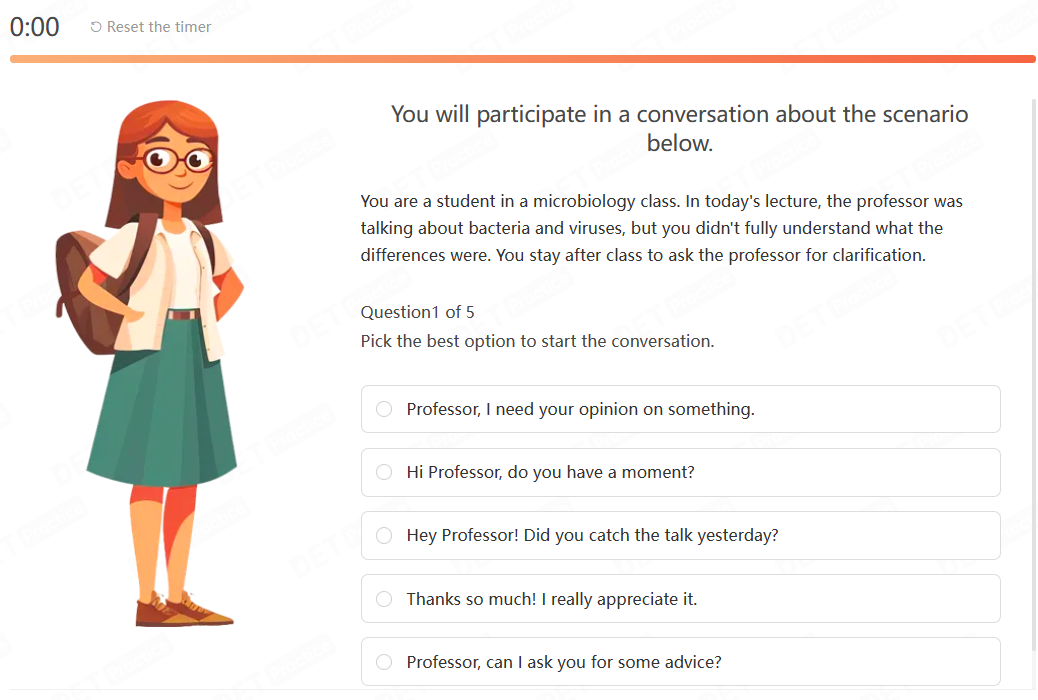
Recuerda rápidamente el Escenario que acabamos de ver. De esta forma, solo la opción 5 es la respuesta más apropiada.
l Sigamos viendo la pregunta:
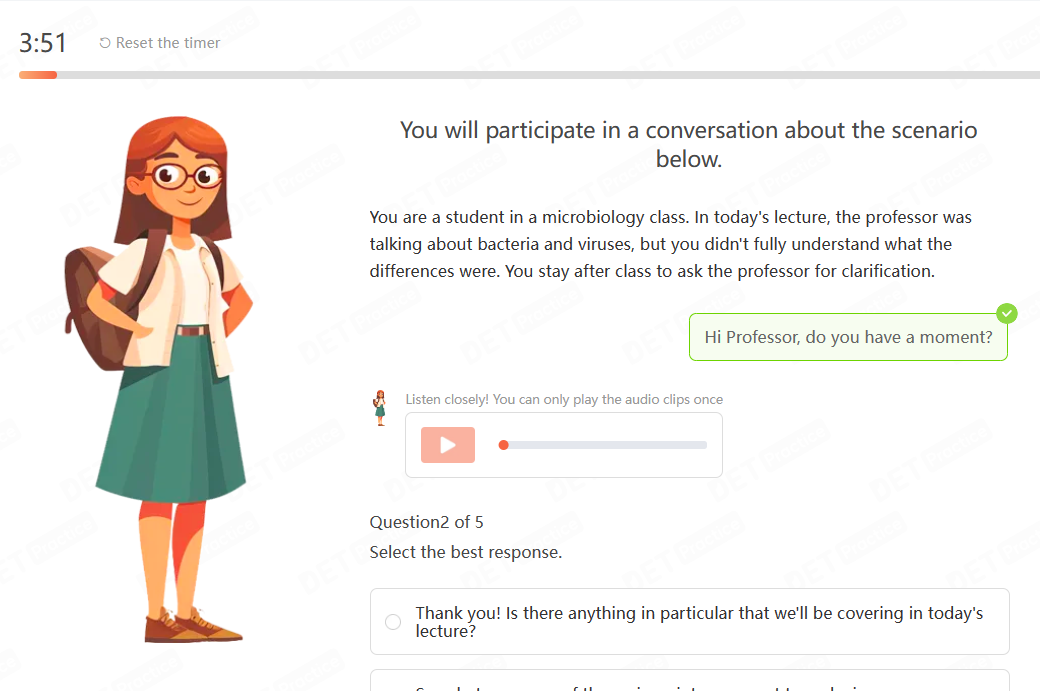
Aquí vemos que tus elecciones anteriores y el contenido escuchado se muestran. Esto es útil para quienes rinden el examen, ya que facilita las preguntas.
¿Cómo elegimos las respuestas? ¿Recuerdas el Escenario previo? Los ejemplos muestran el propósito del Escenario y los guiones que siguen. Esta información puede ayudarte a contestar las próximas preguntas de opción múltiple.
Después de la sección “Listen and Respond”, verás todos los guiones de listening. Como mencionamos, normalmente te quedarán 1–2 minutos para responder. Aprovecha ese tiempo para repasar el texto y memorizar los puntos clave de la conversación, ya que la pregunta más desafiante, “Summarize the Conversation”, está por venir.
Summarize the Conversation
Primero, veamos la interfaz de la pregunta:
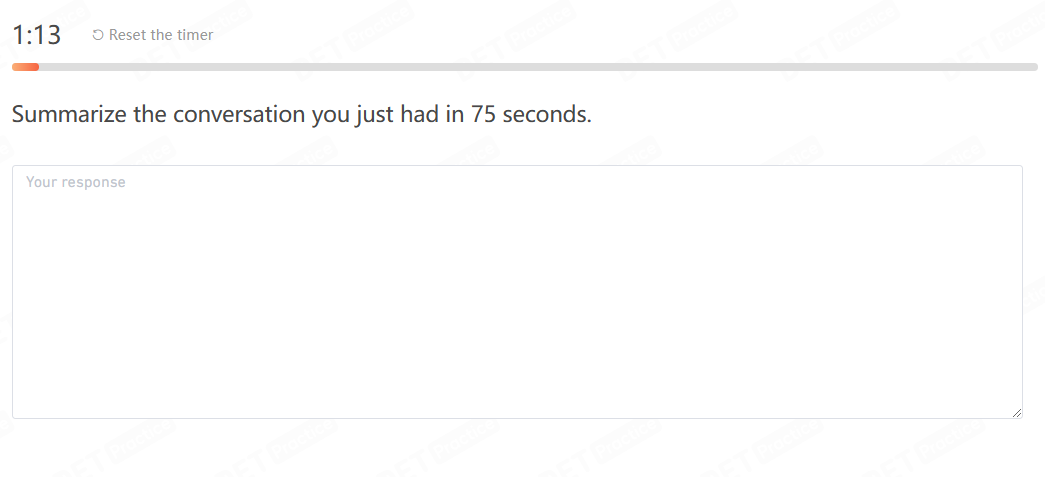
Esta es una situación desesperante. En esta interfaz, aparte de recordarte que tienes solo 75 segundos para responder, no hay nada más. Así es, no podrás volver a ver la conversación anterior de listening. Por lo tanto, solo podemos escribir un resumen de la conversación basándonos en la memoria. La dificultad de esta pregunta radica en que exige buena memoria a corto plazo y rapidez al teclear. ¿Cómo podemos obtener la mayor cantidad de puntos posible en esta pregunta? Primero, estos son algunos detalles a tener en cuenta:
1. Usa la primera persona en el resumen
2. El tiempo verbal pasado y presente serán los más habituales
3. Intenta incluir la mayor cantidad de detalles posible de la conversación de listening en tu escritura
Si tienes dudas sobre los 3 puntos anteriores, puedes ver el Ejemplo de Ensayo.

Estrategias de respuesta para la mayoría de los Examinados
l Si tu memoria a corto plazo no es muy buena, o tu base de vocabulario y tu habilidad auditiva son débiles, y no comprendes completamente el contenido de la conversación, te sugerimos que te apoyes en el Escenario.Este Escenario realmente es un resumen de la conversación de listening (aunque le faltan detalles). En el tiempo restante después de finalizar la parte de “Listen and Respond”, concéntrate en memorizar la parte del Escenario e intenta reproducirla en la redacción posterior. Por supuesto, lo ideal es parafrasearla con tus propias palabras en vez de copiarlo tal cual.
l Si tu velocidad de escritura no es suficiente, te aconsejamos visitar typing.com o keybr.com para practicar de 15 a 30 minutos tu velocidad de tecleo cada día. Si vas a prepararte en poco tiempo, te sugerimos dominar al menos una estructura de redacción para “Interactive Listening” antes del examen, pues si tienes que pensar la estructura durante los 75 segundos de respuesta, no lograrás escribir mucho contenido.
Si tu nivel de inglés aún no es bueno, te recomendamos probar el método sugerido para prepararte o responder las preguntas. ¡Mucho éxito en tu examen DET!
Haz clic aquí para ver más Estrategias de Preparación para DET
Empieza a practicar hoy mismo registrándote gratis en nuestro Banco de Preguntas DET gratis.


